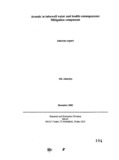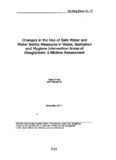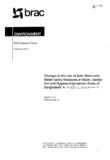Browsing by Subject "Tubewell"
Now showing items 1-6 of 6
-
Arsenic in tubewell water and health consequences: mitigation component
(BRAC Research and Evaluation Division (RED), 2003-12) -
Awareness and choice of options of Arsenic-free drinking water
(BRAC Research and Evaluation Division (RED), 2000)The discovery of arsenic contamination in tubewell water has created concern for its potential health effects. BRAC initiated an arsenic mitigation project in two upazilas in 1999. The project included promotion of ... -
Changes in the use of safe water and water safety measures in water, sanitation and hygiene intervention areas of Bangladesh: a midline assessment
(BRAC Research and Evaluation Division (RED), 2011-11)The BRAC Water, Sanitation and Hygiene (WASH) programme reached 150 upazilas (sub-districts) in collaboration with the Government of Bangladesh since 2006. This study assessed the changes in the use of tubewell water and ... -
Changes in the use of safe water and water safety measures in water, sanitation and hygiene intervention areas of Bangladesh: a midline assessment
(BRAC Research and Evaluation Division (RED), 2010-12)The BRAC Water, Sanitation and Hygiene (WASH) programme reached 150 upazilas (sub-districts) in collaboration with the Government of Bangladesh since 2006. This study assessed the changes in the use of tubewell water and ... -
Comparative status of safe water use and hygiene practices in areas with and without NGO-Ied Water, Sanitation and Hygiene (WASH) Programme
(BRAC Research and Evaluation Division (RED), 2011-01)More than 90% people in Bangladesh have access to improved water supply system, but arsenic is posing a threat to this achievement. Additionally, hygiene is considered as one of the challenging areas to deal in the ... -
Sustainable community- based safe water options to mitigate the Bangladesh arsenic catastrophe - an experience from two upazilas
(BRAC Research and Evaluation Division (RED), 2003-05)Sustainable community-based safe water options have been successfully operating in two upazilas involving 531 villages and encompassing a population of 497,488. Testing of tubewells for arsenic was carried out on a census ...






